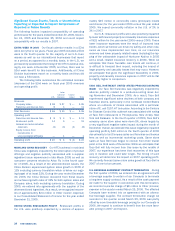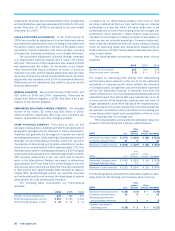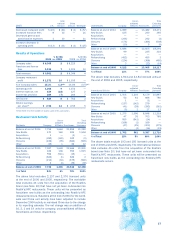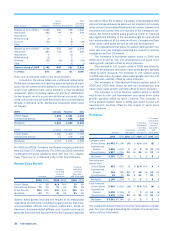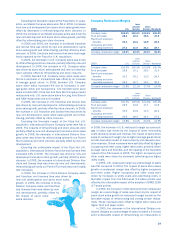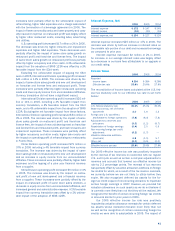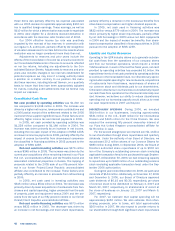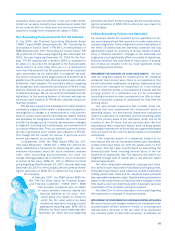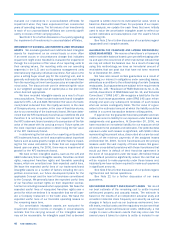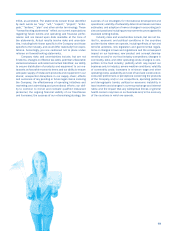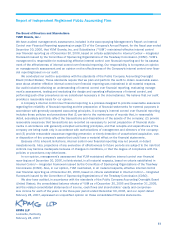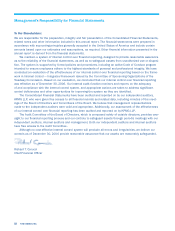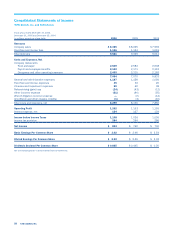Pizza Hut 2006 Annual Report Download - page 39
Download and view the complete annual report
Please find page 39 of the 2006 Pizza Hut annual report below. You can navigate through the pages in the report by either clicking on the pages listed below, or by using the keyword search tool below to find specific information within the annual report.
44 YUM! BRANDS, INC.
The funding rules for our pension plans outside of the
U.S. vary from country to country and depend on many factors
including discount rates, performance of plan assets, local
laws and tax regulations. Our most significant plans are in the
U.K., including a plan for which we assumed full liability upon
our purchase of the remaining fifty percent interest in our for-
mer Pizza Hut U.K. unconsolidated affiliate. During 2006, we
made a discretionary contribution of approximately $18 mil-
lion to our KFC U.K. pension plan in anticipation of certain
future funding requirements. Since our plan assets approxi-
mate our projected benefit obligation at year-end for this plan,
we do not anticipate any significant further, near term funding.
The projected benefit obligation of our Pizza Hut U.K. pension
plan exceeds plan assets by approximately $35 million. We
anticipate taking steps to reduce this deficit in the near term,
which could include a decision to partially or completely fund
the deficit in 2007. However, given the level of cash flows
from operations the Company anticipates generating in 2007,
any funding decision would not materially impact our ability to
maintain our planned levels of discretionary spending.
During 2006, Congress passed the Pension Protection
Act of 2006 (the “Act”) with the stated purpose of improving
the funding of America’s private pension plans. The Act intro-
duces new funding requirements for defined benefit pension
plans, introduces benefit limitations for certain under-funded
plans and raises tax deduction limits for contributions. The Act
applies to pension plan years beginning after December 31,
2007 and is applicable only to our U.S. Plan. We have pre-
liminarily reviewed the provisions of the Act to determine the
impact on the Company. Required funding under the Act will be
dependent upon many factors including our U.S. Plan’s future
funded status as well as discretionary contributions we may
choose to make. Based upon this preliminary review as well
as the current funded status of the U.S. Plan relative to our
level of annual operating cash flows, we do not believe that
required contributions under the Act would materially impact
our operating cash flows in any one given year.
Our postretirement plan is not required to be funded in
advance, but is pay as you go. We made postretirement bene-
fit payments of $4 million in 2006. See Note 15 for further
details about our pension and postretirement plans.
We have excluded from the contractual obligations table
payments we may make for: workers’ compensation, employ-
ment practices liability, general liability, automobile liability and
property losses (collectively “property and casualty losses”)
for which we are self-insured; employee healthcare and long-
term disability claims for which we are self-insured; and
income taxes and associated interest we may pay upon audit
by tax authorities of tax returns previously filed. The majority
of our recorded liability for self-insured employee health, long-
term disability and property and casualty losses represents
estimated reserves for incurred claims that have yet to be
filed or settled. We provide reserves for potential tax and
associated interest exposures when we consider it probable
that a taxing authority may take a sustainable position on a
matter contrary to our position.
Off-Balance Sheet Arrangements
We had provided approximately $16 million of partial guar-
antees of two franchisee loan pools related primarily to the
Company’s historical refranchising programs and, to a lesser
extent, franchisee development of new restaurants at Decem-
ber 30, 2006. In support of these guarantees, we posted
letters of credit of $4 million. We also provided a standby let-
ter of credit of $18 million, under which we could potentially
be required to fund a portion of one of the franchisee loan
pools. The total loans outstanding under these loan pools
were approximately $75 million at December 30, 2006.
Any funding under the guarantees or letters of credit
would be secured by the franchisee loans and any related
collateral. We believe that we have appropriately provided for
our estimated probable exposures under these contingent
liabilities. These provisions were primarily charged to net
refranchising loss (gain). New loans added to the loan pools
in 2006 were not significant.
Our unconsolidated affiliates have approximately $29 mil-
lion of short-term debt outstanding as of December 30, 2006,
none of which is guaranteed by YUM.
Accounting Pronouncements Adopted in the
Fourth Quarter of 2006
In the fourth quarter of 2006, we adopted Staff Account-
ing Bulletin No. 108, “Considering the Effects of Prior Year
Misstatements when Quantifying Misstatements in Current
Year Financial Statements” (“SAB 108”). SAB 108 provides
interpretive guidance on how the effects of the carryover or
reversal of prior year misstatements should be considered in
quantifying a current year misstatement for the purpose of
a materiality assessment. SAB 108 requires that registrants
quantify a current year misstatement using an approach that
considers both the impact of prior year misstatements that
remain on the balance sheet and those that were recorded in
the current year income statement. Historically, we quantified
prior year misstatements and assessed materiality based on
a current year income statement approach. The transition
provisions of SAB 108 permitted the Company to adjust for
the cumulative effect of uncorrected prior year misstatements
that were not material to any prior periods under our histori-
cal income statement approach but that were material under
the guidance in SAB 108 through retained earnings at the
beginning of 2006. See Note 2 for further discussion on the
impact of adopting SAB 108.
In the fourth quarter of 2006, we adopted the recogni-
tion and disclosure provisions of SFAS No. 158, “Employers’
Accounting for Defined Benefit Pension and Other Postretire-
ment Plans — an amendment of FASB Statements No. 87,
88, 106 and 132(R)” (“SFAS 158”). SFAS 158 required the
Company to recognize the funded status of its pension and
post-retirement plans in the December 30, 2006 Consolidated
Balance Sheet, with a corresponding adjustment to accumu-
lated other comprehensive income, net of tax. Gains or losses
and prior service costs or credits that arise in future years
will be recognized as a component of other comprehensive
income to the extent they have not been recognized as a com-
ponent of net periodic benefit cost. The impact of adopting
SFAS 158 has been included in the Company’s December 30,
2006 Consolidated Balance Sheet. See Notes 2 and 15 for
further discussion of the impact of adopting SFAS 158.
SFAS 158 also requires measurement of the funded sta-
tus of pension and postretirement plans as of the date of a


